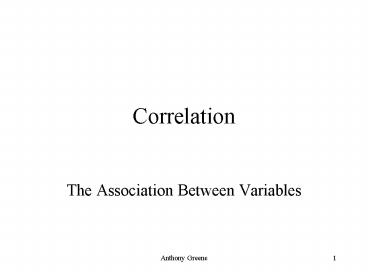Correlation PowerPoint PPT Presentation
1 / 29
Title: Correlation
1
Correlation
- The Association Between Variables
2
When to Use
- t-test or
ANOVA - When the independent variable is Categorical
3
When to Use
- Correlation
- Regression
- When the independent variable is Ratio or Interval
4
ScatterPlots
5
ScatterPlots
6
Times and costs for five word-processing jobs
7
Four data points
8
Direct Relationship Positive Slope
9
Age and price data for a sample of 11 used cars
10
Scatter diagram for the age and price data of
used cars
11
Inverse Relationship Negative Slope
12
Various degrees of linear correlation (Slide 1 of
3)
13
Various degrees of linear correlation (Slide 3 of
3)
14
Various degrees of linear correlation (Slide 2 of
3)
15
Examples of positive and negative relationships
16
The Simple Idea
- If the corresponding x and y z-scores are always
in agreement, r will be high. - If they are sometimes in agreement r will be
moderate - If they are generally different, r will be near
zero - If they are in agreement, but in opposite
directions, r will be negative
17
The Basic Idea
Zx Zy Zx Zy Zx Zy
1.2 1.6 1.2 -2.3 1.2 -1.6
-1.1 -0.7 -1.1 -0.2 -1.1 0.7
0.8 1.1 0.8 1.6 0.8 -1.1
3.2 2.8 3.2 -0.7 3.2 -2.8
-2.7 -2.3 -2.7 1.1 -2.7 2.3
0.1 -0.2 0.1 2.8 0.1 0.2
18
Notation Used in Regression and Correlation
We define SSx, SSp and SSy by
19
Obtaining the three sums of squares for the used
car data using the computational formulas
20
Linear Correlation Coefficient
The linear correlation coefficient, r, of n data
points is defined by or by the computational
formula
21
Linear Correlation Coefficient
22
Coefficient of Determination
The coefficient of determination, r2, is the
proportion of variation in the observed values of
the response variable that is explained by the
regression The coefficient of the
determination always lies between 0 and 1 and is
a descriptive measure of of the utility of the
regression equation for making predictions.
Values of r2 near 0 indicate that the regression
equation is not useful for making predictions,
whereas values near 1 indicate that the
regression equation is extremely useful for
making predictions.
23
t-Distribution for a Correlation Test
For samples of size n, the variable has the
t-distribution with df n 2 if the null
hypothesis ? 0 ? or rho is pronounced row
24
The t-test for correlation (Slide 1 of 3)
With df n-2 use table B.6
25
The t-test for correlation (Slide 2 of 3)
26
The t-test for correlation (Slide 3 of 3)
Step 4 Compute the test statistic r. Table B.6
allows a direct lookup. Alternatively, r has a t
distribution and Table B.2 will yield an
identical conclusion Step 5 If the value of
the test statistic falls in the rejection region,
reject the null hypothesis. Step 6 State the
conclusion in words
27
Criterion for deciding whether or not to reject
the null hypothesis
28
Correlation Matrix
a b c d
a 1.00
b 0.84 1.00
c 0.68 0.58 1.00
d 0.12 0.19 0.08 1.00
29
Computer printouts for correlations

